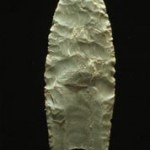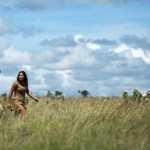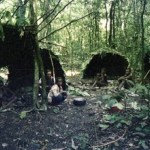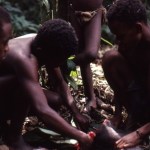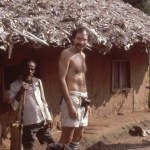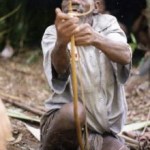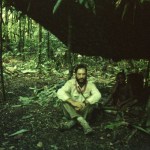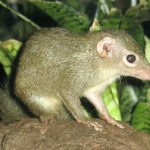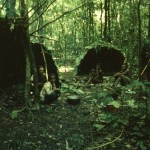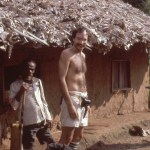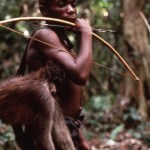Efe Ethnoarchaeology
A claim is being made, in a recent issue of Nature Magazine, that humans were active in the vicinity of San Diego well over 100,000 years before archaeologists think humans were even in the New World. Most commentary on this claim dismisses it out of hand, but out of hand rejections are no better than foundationless assertions. Let's take a closer look at the Cerutti Mastodon Site. But first, some important context.
The Near Consensus on North American Prehistory
The Clovis Culture is a Native American phenomenon that occurred between about 12 and 10 thousand years ago (most likely between…
The Lese people practice swidden horticulture in the Ituri Forest, Congo (formerly Zaire). Living in the same area are the Efe people, sometimes known as Pygmies (but that may be an inappropriate term). The Efe and Lese share a culture, in a sense, but are distinct entities within that culture, as distinct as any people living integrated by side by side ever are. The Efe are hunter-gatherers, but the gathering of wild food part of that is largely supplanted by a traditional system of tacit exchange between Efe women and Lese farmers, whereby the Efe provide labor and the farmers provide…
The Great Human Race is a new production of National Geographic, in three parts. I recently viewed the first episode, "Dawn" which comes with this description:
All people can trace their roots to the savanna of East Africa, the home of one of the first members of the human species -- Homo habilis. Archaeologist Bill Schindler and survival instructor Cat Bigney face what early man did as they work together to survive in the wild savanna just as these primitive people did 2.6 million years ago -- without any weapons or fire. But they soon find that living like our ancestors is harder than…
“First, we’re going to collect our data,” Jack, the archaeologist, was telling me as we slogged down the narrow overgrown path. He seemed annoyed. “Then, we’ll leave. Until we leave, they won’t leave. They think it would be rude. After they leave, we’ll go back and map in the abandoned camp.”
I had just arrived at the research camp in the Ituri Forest, then Zaire and now the Congo, after a rather long and harrowing journey that took me from Boston to New York to London to Lagos to Kinshasa to Kisingani to Isiro, all by plane, then over 250 kilometers of increasingly less road-like road, to…
All human hunter-gatherer groups that have been studied incorporate meat in their diets. Studies have shown that the total dietary contribution of meat varies a great deal, and seems to increase with latitude so that foragers in subarctic and arctic regions eat a lot of meat while those living near the equator eat less. It is probably true that tropical and subtropical foragers obtain more of their calories from plants than from meat over any reasonable amount of time. The meat consists primarily of mammals for most groups, but fish, birds, reptiles, and invertebrates can reach high…
I first became aware of, and read, King Leopold's Soliloquy, which is not his soliloquy but a parody of what he might say according to Samuel Clemens, while doing fieldwork in the ex-Belgian Congo. That is where the real story that inspired the essay took place. I lived in an area that at one time had a few a plantations, but the plantations only existed briefly and are now long gone. The "road" through this area was passable only with a very tenacious four wheel drive vehicle (we had a Land Rover) and grew worse every year. But the road at one time was excellent.
I knew a guy, an older…
Left: Efe (Pygmy) man. Right: White guy.
Some of the people who live in the rain forest of Central Africa are known widely as "Pgymies." That word...Pygmy...is considered problematic for a few different reasons. It refers to a person's physical appearance, because it means "small." The word is sometimes used in biology to refer to the smaller species among a group of closely related species, as in "Pygmy Hippopotamus" or "Pygmy Chimp." In English and probably some other languages, the term is used in a derogatory way to refer to someone who is perceived as not very smart, as in "Pygmy…
A compendium of selected posts written about the Ituri Forest, the Efe Pygmies, and other folks and other things in the region:
In the matter of insects:
No Place to Sit Down
The reason the Efe won't normally kill an insect ...
"Excuse me, there's some food in my bugs!"
Day of the locust. Yum!
"We Live In Little Houses Made of Beans"
The curious world of bugs
Life in the forest
How to kill a monkey
How to carry your monkey home once you've killed it
A story of my friend Kobou
Camp life
Cultural Wanderings
A look at some traditional medicine, cross culturally
Total eclipse of the sun and…
Continuing with the theme of eating insects ...
The people of the eastern Congo plant African rice around June so that it will grow through the wettest part of the wet season, and then they harvest it in the "dry season" which starts about mid or late November. That is around the same time that a "locust" (actually a katydid of some sort) emerges in the grasslands to the north, in the Central African Republican and the Sudan, to spread across the region. And eat rice.
It is rather annoying to have locust descend on your crops. Some years it is not too bad, some years it is bad enough to…
Speaking of people eating insects ... as we were ... I do have this fun story from the Ituri Forest.
One day something funny happened. I was traveling in the most remote part of Central Africa, several days walk from any place you could possibly drive a car, visiting uncharted villages mainly occupied by people who had moved into the deep forest because they were in trouble with the "law" in some way (usually for perfectly good reasons in this lawless country). I was traveling with a Lese Villager and his sister, who was hired as our cook, and three Efe Pygmy men. We visited a village that…
that has wandered into their camp if they don't know anything about it a priori is ... according to what they told me when that happened once ... is ...
Many, though certainly not all, insects are linked to important things in life. This is true of many things that are not insects as well. For instance, one does not walk to the right of a young male Canarium tree in the afternoon, because he who shall not be named could be sitting in the tree, and then you're screwed. Or, one should not handle the fetus of an antelope if any females in your family are planning on getting pregnant soon…
I knew a couple who had spent a lot of time in the Congo in the 1950s. He was doing primatology, and she was the wife of a primatologist. And when she spoke of the Congo or Uganda, where they spent most of the time, she always said two things that always put me off a little. First, she would Uganda and Congo as "Africa" (which is technically correct, but I've yet to hear of someone saying "I'll spend Spring Break in North America" on their way to Cancun) and she'd always say "The thing about Africa is that there's no place to sit down."
It turns out that there are plenty of chairs and…
It has been said that our most distant primate ancestors, the mammal that gave rise to early primates but itself wasn't quite a primate, was most like the Asian tree shrew, which is neither a shrew nor does it live in trees. This is, of course, untrue. When the average American sees a shrew native to the new world scurrying past, he or she usually thinks of it as a form of mouse. Which it isn't. (In fact, there are no "mice" native to the new world, but even if we give our hypothetical observer the concept of "rodent" as in "eeek, a rodent" the shrew is not that either.) If you spend any…
An Efe forest camp is usually dark and depending on the time of day, dripping from current or recent rain. The Efe live in dome shaped huts which may be more or less complete. A half dome might be a hut that was built quickly, or it might be a hut that was built more openly because it has been hot or it might be only a half dome to allow easier access in and out of the hut by children or individuals with injury or infirmity. A fully domed hut, with a small opening, keeps in more smoke (a fire is often kept in the hut) but it also keeps in the heat and keeps out the rain. So a rainy…
When I first arrived in the Ituri Forest I was shown a camp a group of Efe Pygmies all typically lived in, and told "everyone lives here but the old man and his wife ... he's a bit contentious and there was an argument." Having read all the literature written in English about Pygmies, I was aware of the fact that these foraging people, who moved frequently -- perhaps ten times a year or more -- would often change the composition of their residence groups to reflect forming and breaking alliances among people who often, but not always, lived together. After hanging out in the camp, which was…
Once you've killed the monkey, you need to carry it back to camp. Slit the tail, near the end, and poke the head through the slit, so the tail makes a handy strap.
Here's a detail:
An Efe (Pygmy) man making poison arrows for use in killing monkeys.
Ituri Forest, Zaire. Photograph Copyrighted 1986 Greg Laden
The arrows are thin darts of wood, often made of palm. Large marantacae leaves serve as a bowl and as a ladle. The poison includes a large number of ingredients, and the specific recipes vary a great deal (and are often guarded). This concoction included the juice pounded from a vine that contains strychnine. About seven arrows are fired at a monkey, up in the trees, per strike (on average) and it takes about two strikes to bring down a monkey. Several dozen…
